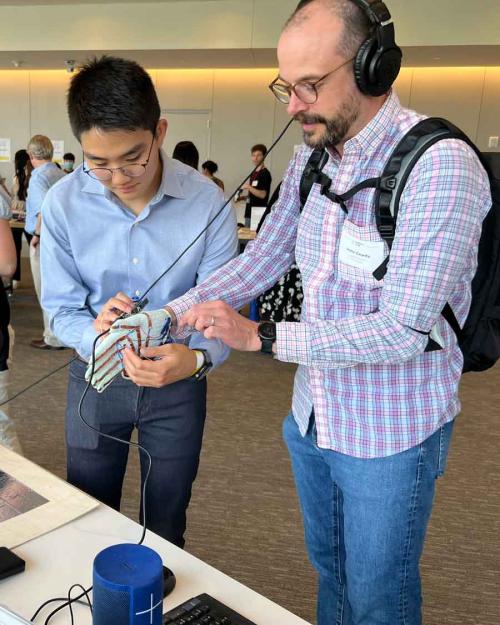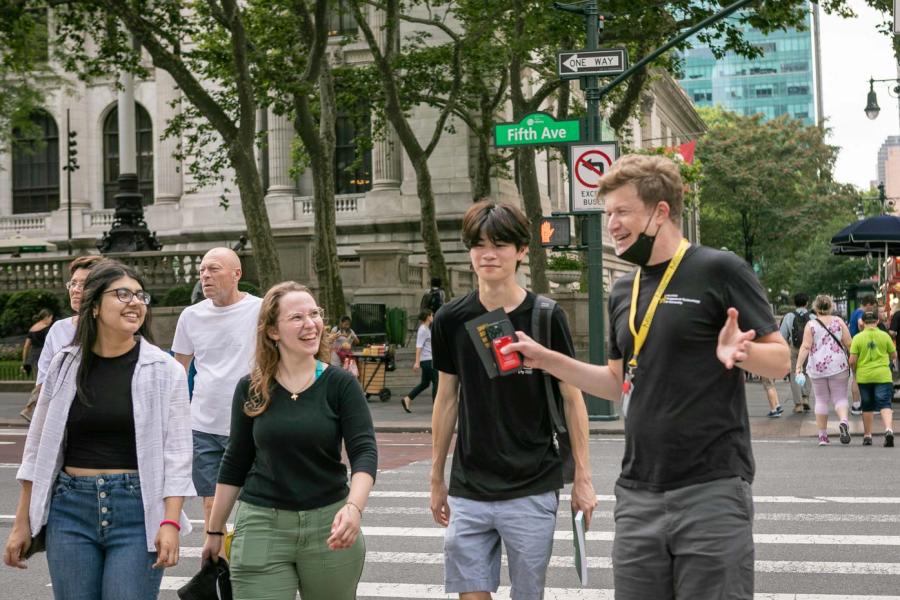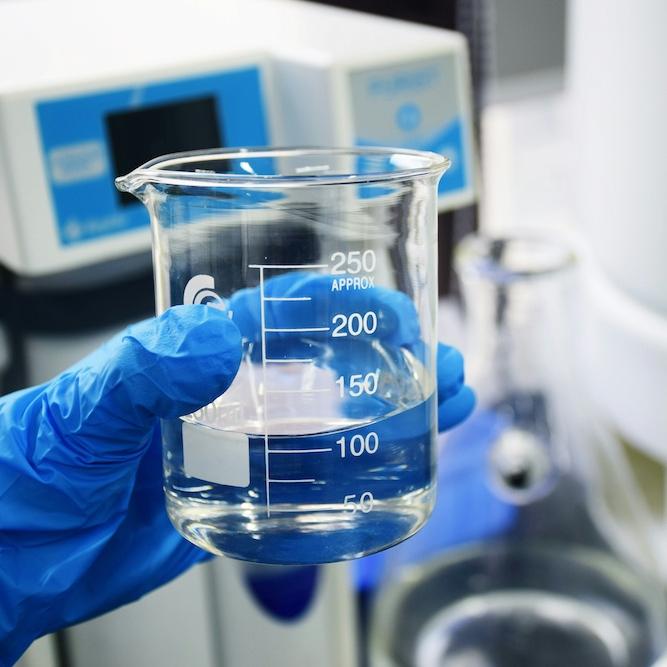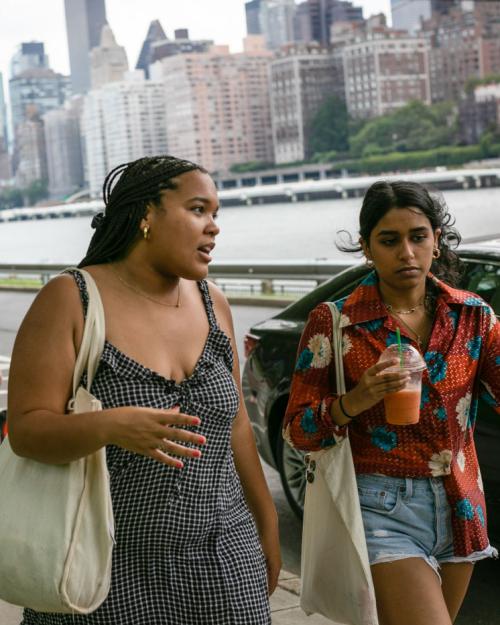At the end-of-summer showcase for students in the Milstein Program in Technology & Humanity, James Koga ’25 had a host of things on display: an interactive glove he developed and coded that allows people to create music or poetry by tapping their fingers; a 3D digital museum that he and other students built for artworks created by patients and residents of Coler Hospital on Roosevelt Island; a 3D-printed personalized charging station for his phone; and a few more things.
“Being a part of an inspiring cohort, at least for me, has inspired me to do all sorts of things,” said Koga, who plans to major in computer science, along with science and technology studies.
Koga was one of 29 Milstein students who spent eight weeks this summer at the Cornell Tech campus in New York City, where he created, learned, explored and wrestled with a number of societal questions about how technology could be used to:
- Provide products for people with hand mobility issues;
- Ease the voting process for people who don’t speak English;
- Increase access to mental health services;
- Encourage adults to read more;
- Improve the success of urban gardens;
- Help residents prepare for climate change and natural disasters;
- and tell their own personal stories.
While Milstein students are all huge fans of technology, summer program faculty also led them through exercises that helped them step back to consider technology’s impacts.
They considered how looking at the world’s big problems through a humanities lens can help them decide whether technology offers the appropriate solution. And they considered issues of accessibility and inclusivity, way beyond the normal definitions of those terms.
“Just because we can do something, does that mean we should do it?” said Howard Milstein '73, whose $20 million gift, with Abby Milstein and Michael Milstein '11, launched the Milstein Program in 2017. “In order to answer that question, we need to look back at civilization and the humanities for the answer. This program trains future leaders to ask the right questions about technology by bringing a humanities frame to the issues. It acknowledges that technology is essential for progress, but that humanities are essential for critical thinking.”
Carlton Cassedy '24 has thought a lot about how technology could solve problems and improve efficiency. "I've always been someone who has intellectual interests in the humanities and in STEM,” he said. "As much as I enjoy doing computer science, I want to use the technology right, to solve big problems such as climate change.”
Elida Met-Hoxha ’24 also worked on a dizzying number of projects during her eight weeks, including FloodNet, a project that installed real-time flood sensors throughout New York City. Her task: create a campaign/tool that explains the project to the public, so that people don’t think the sensors are capturing personal information.
“We wanted to create an augmented reality experience that shows people how the sensor works and that it's not taking videos or pictures, just collecting numerical data, but there’s a problem with accessibility,” Met-Hoxha said. “You want anyone to be able to access it, not just someone who has technology. There's also the problem of language accessibility with so many languages being spoken in New York City. There are a lot of interesting things to think about with this project that we don’t always consider.”
At their showcase, students presented projects they had created in physical and digital labs, through civic engagement experiences and in their own time as personal work, inspired by their instructors, the equipment they had at the ready and by each other.
“While the final showcase culminated in a dynamic display of the students’ technical, creative and critical skills, and it also served as a testament to the Milstein Program’s core ambitions surrounding cohort-building and collective growth,” said Michael Byrne, a research fellow at Cornell Tech’s Digital Life Initiative who leads the summer program along with Cornell Tech’s Angeline Gomez. “It has been a joy to have these phenomenal students with us at Cornell Tech for the summer, and we are excited to watch their development back in Ithaca as they continue to examine today’s pressing issues through a unique socio-technical lens.”
Immersed in tech
Students in this summer program are a subset of the 100 students who have been accepted into the Milstein Program — roughly 25 from each class — from thousands of students who apply each year. It’s for students who are interested in collaborating with others to explore the ways that emergent technology can be used to engage with today’s most pressing issues.
During the academic year, Milstein students enjoy Faculty Fellow seminars, short courses, guest speaker presentations, mentorship and career development sessions and funded research opportunities. They also spend one summer in the immersive experience at Cornell Tech. The summer gives Milstein students access to a host of people, materials, resources and encouragement to come up with creative projects and ideas and follow through on them.
Those staff include Cornell Tech staff Byrne and Gomez and instructors Irwin Chen, director of visualization design at the Mintz Group and the design lead at the Journalism + Design Program at The New School; Bil Leon, MBA ’20, founder and COO of Malamute; Niti Parikh, creative lead in the MakerLAB at Cornell Tech and Oscar Romero, chief information officer of New York City’s Civic Engagement Commission.
“One of the best things about the Milstein space is that they provide you with the 3D printer, the Arduino board (a computer Koga needed for his glove), the materials, the software and the help,” Koga said. “All of our instructors know how to help and they're really accessible.”
Rhea Verma ’25 used a 3D printer to create a globe and a vinyl cutter to fashion labels for a personal project about her life.
“When I was little, I moved around a ton because of my parents’ jobs and it really shaped who I am in terms of how I adapt to new situations,” Verma said.
On her globe, Verma attached a headline to each location where she’s lived, illustrating the stages and interests she had during that time. “When I think of how to represent myself, I always think of something global.”
Along with their classes and projects on the Cornell Tech campus, Milstein students venture to museums, plays and other points of interest across the city and also travel to a Tech Explorations event every other Tuesday at Company Ventures, a seed-stage venture firm of which Michael Milstein is a partner, where they connect with a tech entrepreneur and hear their story.
“A lot of the people we heard from work in the tech sphere of New York City, so it's really interesting to see how they've started off their careers and how their careers are progressing,” said Zayana Khan ’25, “because that could potentially be us. I'm sure a lot of us are going to end up making startups.”
Michael Milstein agreed, adding: “Through building successive cohorts of graduates attuned to the interconnectedness of technology and the humanities, we’re building a cadre of leaders who can depend on each other and steer to a future technology imbued with ethics.”
Solving community problems
At the beginning of the summer, students took part in an exercise that helped them brainstorm ways that technology could be used to address various community issues.
Julia Beitel ‘24, Krystal Ohuabunwa ’25 and Ben Upshaw ’25 landed at a table with cards labeled education, diversity and health care as the issues they needed to consider as they devised a project. Their idea was to create an urban planning tool based on the SIMS video game to improve access to health care and healthy food options for people in neighborhoods with few parks.
“The virtual model captures exactly what we wanted it to be,” Upshaw said. “It’s scalable to a vacant plot of land.”
The group researched the Highbridge neighborhood in the Bronx as they planned their design, which includes vegetable plots, chicken coops, planters, health clinics, rest rooms and green spaces.
Catherine Martin ’25, Neeya Hamed ’25 and Coco Xu ‘24 wanted to find a way to support local fashion businesses, so they created an app that helps people learn about the labor practices of large clothing companies, allowing them to make more sustainable buying choices.
Romero worked with the students to connect them to five nonprofits, small businesses and agencies in the city in need of technology-related help. Those projects included the Coler Hospital (a chronic care facility that provides rehabilitation and special nursing services) and FloodNet projects, along with a mental health startup and two projects with the city’s Civic Engagement Commission related to volunteer communication and voter engagement.
One of Romero’s goals was to show students the role of a public service agency in addressing inequality in the tech sector and the importance of challenging inequality wherever they see it, no matter what career they find themselves in.
“Last year, everything the students did for the nonprofits was used; their work won awards,” Romero said. “And many of the policy recommendations they worked on got implemented by the city.”
Gaining a new group of friends
Along with their projects, Milstein students say the summer experience helped them gain a deeper understanding of New York City, good and bad.
“When I first went on the subway, I had all of these romantic notions and ideals of what the city's supposed to be like, but everyone in the subway just looks tired,” Met-Hoxha said. “Then again, I feel like this is the truth for any city.”
And it created a new cohort of friends that they’ll carry with them back to campus.
“This summer cemented us as a really good community of friends,” Koga said. “I didn't even know anybody coming into this, but I feel pretty comfortable with everybody now.”
“When you're in New York City and you're exploring, you spend a lot of time with these people and you really get to know them,” Khan said. “I feel like everyone here is so incredibly talented. Working on projects with them is simultaneously a way of making an impact and learning.”










